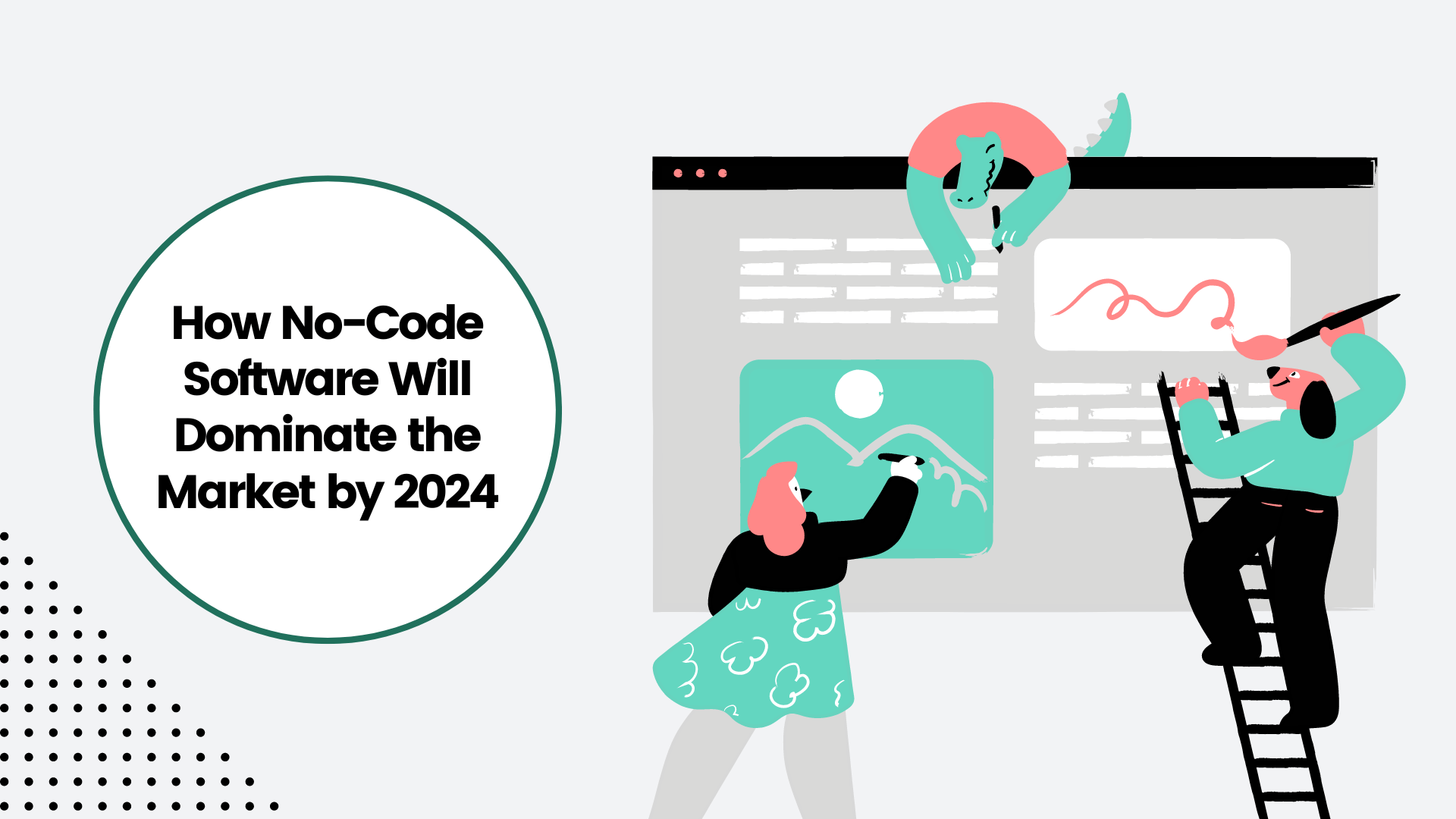No-code software development is exploding in popularity as startups and small businesses tighten the reins on their technology costs due to economic uncertainty. This greater protection of resources is causing many CEOs to turn to no-code applications that they can learn on their own and create the app or website without having to hire a developer.
By 2024, it’s estimated over 50% of business applications will be built using no-code platforms. This is a huge increase from the 10% that Gartner Research estimates are currently created using no-code. So let’s dive into how no-code software is slowly taking over as an alternative to hiring developers and why this trend will only continue to increase.
Table of Contents
What Is No-Code?
To start, let’s define what exactly this term means. No-code is a platform that allows users to create applications without writing code. It is sometimes also referred to as low-code or declarative programming.
The term was first coined by David Heinemeier Hansson in 2005 when he released the Ruby on Rails web application framework.
Since then, no-code has gained much traction, and many different no-code platforms are available. Some of the most popular include Bubble, Appy Pie, and Wix. No-code platforms typically come with a drag-and-drop interface that makes it easy to create complex applications without any coding experience.
Why Is No-Code Becoming So Popular?
There are a number of reasons why no-code is becoming increasingly popular. First, creating an application from scratch can be costly and time-consuming. No-code platforms allow you to create an app without having to pay for expensive developers.
Another reason is speed. With no-code platforms, you can create an app in a fraction of the time it would take to develop one from scratch. Again, this is because you don’t have to write code or spend time learning how to code.
Lastly, no-code platforms are becoming more and more user-friendly. This ease of use means that even people with no coding experience can create complex applications.
Increased Traction for No-Code
There are several reasons for the sudden growth of no-code software. First, platforms are becoming increasingly powerful and sophisticated. You can now use them to build complex applications with a wide range of features and functionality. Plus, they now offer features in traditional coding languages.
Secondly, the cost of building applications using no-code platforms is a fraction of the cost of traditional development approaches. For example, a decade ago, the price of a single no-code platform license could easily exceed $100,000. Today, you can get started with some of the best no-code platforms for less than $10,000 per year.
This change happened because no-code platforms remove the need for expensive developers and allow businesses to build applications using drag-and-drop tools requiring no coding skills.
Third, the pool of talent that knows how to use no-code platforms is growing rapidly. According to Forrester Research, over 1 million “citizen developers” in the US alone are using no-code platforms to build applications for their businesses.
Not to mention no-code platforms are also becoming more and more user-friendly. The best platforms now offer drag-and-drop interfaces that make it easy to build complex applications without coding knowledge.
Finally, the demand for no-code solutions is exploding. According to Gartner, the market for no-code application development platforms will grow from $2.9 billion in 2019 to $13.8 billion by 2024. That’s a compound annual growth rate of 36%!
The rise of low-code/no-code platforms has coincided with a shift in how businesses buy and use technology. In the past, companies would purchase an off-the-shelf application that met their needs. However, businesses are increasingly looking for bespoke applications tailored to their needs.
Considering No-Code for Your Business Needs
So what does all of this mean for you and your business? Suppose you’re not using a no-code platform to build your applications today. In that case, you’re at risk of being left behind by your competitors, who are adopting this more agile and cost-effective approach to software development.
Take the restaurant industry, for instance. Within the past few years, there has been a rise in delivery apps, which have taken a significant percentage of restaurants’ cuts. This scenario has increased the need for restaurants to create their own apps and keep things in-house. No-code has helped with building these restaurant apps without the need for hiring additional assistance, making the whole process a win-win.
Don’t wait until it’s too late to start reaping the benefits of no-code development. Instead, get started today, and you’ll be ahead of the curve when this market explodes in the years to come.
Example of a No-Code App
Though many businesses have successfully used no-code for their app development, likely, you’re not even aware they have used this streamlined method. Many companies are utilizing this tool, but how can you determine a success story when it’s not quite visible?
Many startups, in particular, have used no-code to get their apps up and running while ensuring they’re professional, user-friendly, and high-quality. One example you can view for yourself is this photo-editing app that removes backgrounds, making it easier to upload professional-looking photos for your online store.
This app helps to consolidate the photo editing process in a simple and easy-to-use way.
Pixelcut is to image editing what no-code is to software development, after all.
Staying Ahead of the No-Code Curve
No-code platforms are poised to meet this demand, allowing businesses to quickly and easily build custom applications without the need for expensive developers.
As a result of these factors, it is no surprise that the no-code software market is forecast to grow by $35.73 billion during 2022-2026, accelerating at a Compound Annual Growth Rate (CAGR) of 27.96% during the forecast period. (Source)
Understanding your audience is a key part of owning and running a business. So how can you fully grasp what your brand needs to say, especially to other B2B software brands? There’s a certain psychology behind this, as buyers are motivated by particular concerns. Using no code to quickly and easily scale your company through app development is one effective way to market yourself.
With the no-code software market set to explode in the next few years, let’s look at the key trends helping drive this growth.
No-Code: Powering The Rise Of The Citizen Developer
One of the key drivers of no-code software’s popularity is the rise of the citizen developer. These are non-technical individuals using no-code platforms to build applications without coding knowledge.
The term ‘citizen developer’ was first coined by Forrester in 2009 and refers to “a business person who creates new applications for consumption within their organization, outside of formal IT development processes.” (Source)
Citizen developers are often tasked with creating simple applications or automating processes that would otherwise be manual and time-consuming. This focused work frees up IT resources to work on more strategic projects.
There are several reasons why citizen developers are turning to no-code platforms. Firstly, they can get started quickly and easily without any coding knowledge. Next, they can iterate and test their ideas rapidly without waiting for IT approval or involvement. And finally, no-code platforms tend to be much cheaper than traditional development tools, which makes them more attractive to cost-conscious businesses.
It’s estimated that 80% of enterprises will have policies for citizen developers by 2024. (Source). With the number of citizen developers expected to increase so dramatically over the next few years, it’s clear that no-code platforms will have a big impact on the software development landscape.
How No-Code Helps Traditional Developers
But what does this mean for traditional developers? Will they be replaced by citizens using no-code platforms?
No-code platforms are not a replacement for traditional development tools and methodologies. They are complementary. No-code platforms provide a way for citizen developers to quickly prototype and build applications without writing code. Since no-code assists developers by problem-solving through easier steps, this frees traditional developers to focus on more complex tasks.
In fact, we think the rise of no-code will create more opportunities for traditional developers. As businesses become more comfortable with the idea of using no-code platforms, they will also become more open to the notion of outsourcing development tasks.
This shift is already happening.
We are seeing an increase in the number of businesses that are turning to agencies and freelancers to build no-code applications. So, if you’re a traditional developer, don’t worry. No code is not going to replace you. It might just be your ticket to a bigger and better career.
What Does the Future Hold for No-Code?
The future looks bright for no-code platforms. As they become more user-friendly and affordable, more and more businesses will likely start using them to create applications.
It’s also likely that the market for no-code platforms will become more competitive. This evolution is good news for businesses, as it will drive down prices and improve the quality of the products on offer.
We predict that by 2024, no-code software will dominate the market.

I am a passionate, adventurous, and insatiate learner who loves to write about the latest technology trends. My experience working in an MNC has motivated me to understand that there are certain niche requirements for writing strategically about brands’ messages towards people’s interests which I’ve mastered over time through trial and error of many projects under various clients across diverse industries. It is my honest effort to put my experiences and knowledge of industry towards readers.






